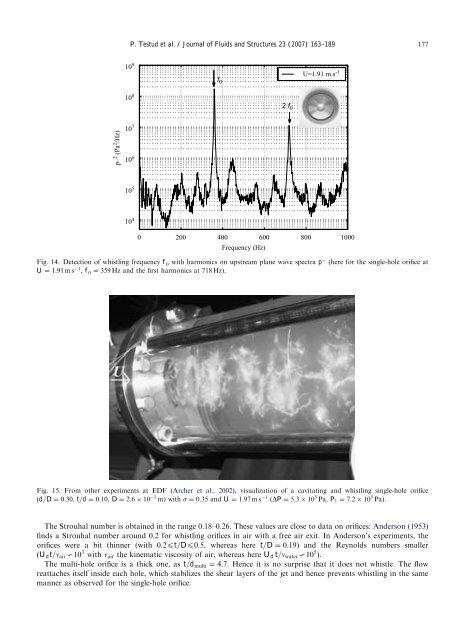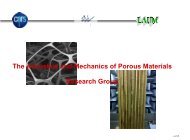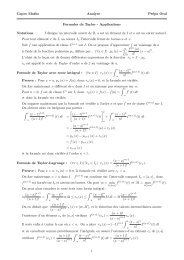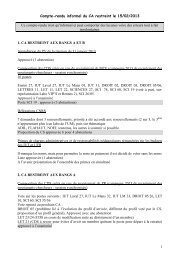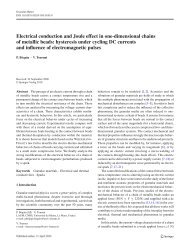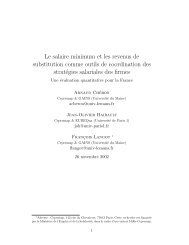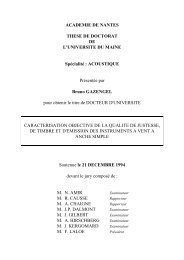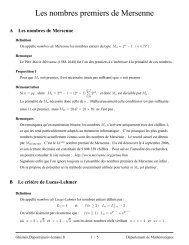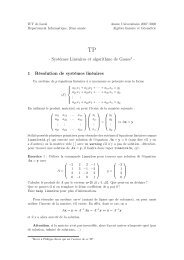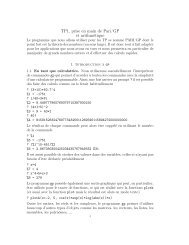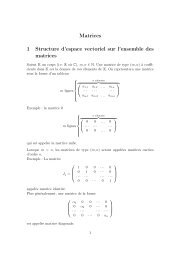Noise generated by cavitating single-hole and multi-hole orifices in ...
Noise generated by cavitating single-hole and multi-hole orifices in ...
Noise generated by cavitating single-hole and multi-hole orifices in ...
Create successful ePaper yourself
Turn your PDF publications into a flip-book with our unique Google optimized e-Paper software.
ARTICLE IN PRESSP. Testud et al. / Journal of Fluids <strong>and</strong> Structures 23 (2007) 163–189 17710 9 Frequency (Hz)10 8f 02 f 0U=1.91 m.s -1p− 2 (Pa 2 /Hz)10 710 610 510 40 200 400 600 800 1000Fig. 14. Detection of whistl<strong>in</strong>g frequency f 0 with harmonics on upstream plane wave spectra pU ¼ 1:91 m s 1 , f 0 ¼ 359 Hz <strong>and</strong> the first harmonics at 718 Hz).(here for the <strong>s<strong>in</strong>gle</strong>-<strong>hole</strong> orifice atFig. 15. From other experiments at EDF (Archer et al., 2002), visualization of a <strong>cavitat<strong>in</strong>g</strong> <strong>and</strong> whistl<strong>in</strong>g <strong>s<strong>in</strong>gle</strong>-<strong>hole</strong> orifice(d=D ¼ 0:30, t=d ¼ 0:10, D ¼ 2:6 10 1 m) with s ¼ 0:35 <strong>and</strong> U ¼ 1:97 m s 1 (DP ¼ 5:3 10 5 Pa, P 1 ¼ 7:2 10 5 Pa).The Strouhal number is obta<strong>in</strong>ed <strong>in</strong> the range 0.18–0.26. These values are close to data on <strong>orifices</strong>: Anderson (1953)f<strong>in</strong>ds a Strouhal number around 0.2 for whistl<strong>in</strong>g <strong>orifices</strong> <strong>in</strong> air with a free air exit. In Anderson’s experiments, the<strong>orifices</strong> were a bit th<strong>in</strong>ner (with 0:2pt=Dp0:5, whereas here t=D ¼ 0:19) <strong>and</strong> the Reynolds numbers smaller(U d t=n air H10 3 with n air the k<strong>in</strong>ematic viscosity of air, whereas here U d t=n water H10 5 ).The <strong>multi</strong>-<strong>hole</strong> orifice is a thick one, as t=d <strong>multi</strong> ¼ 4:7. Hence it is no surprise that it does not whistle. The flowreattaches itself <strong>in</strong>side each <strong>hole</strong>, which stabilizes the shear layers of the jet <strong>and</strong> hence prevents whistl<strong>in</strong>g <strong>in</strong> the samemanner as observed for the <strong>s<strong>in</strong>gle</strong>-<strong>hole</strong> orifice.


